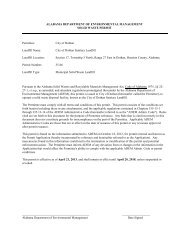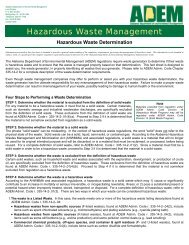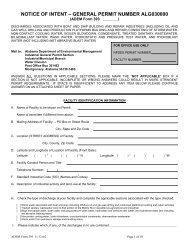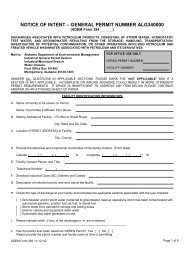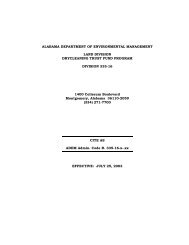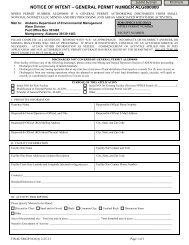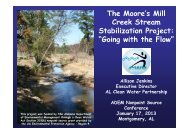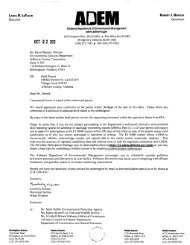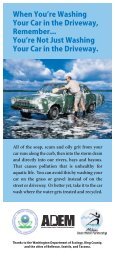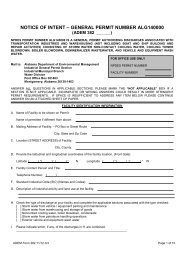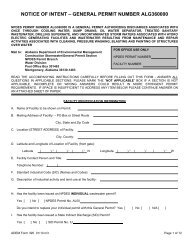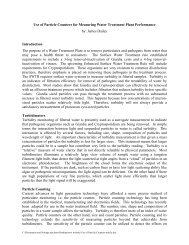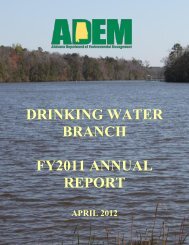alg170000 paint permit - Alabama Department of Environmental ...
alg170000 paint permit - Alabama Department of Environmental ...
alg170000 paint permit - Alabama Department of Environmental ...
You also want an ePaper? Increase the reach of your titles
YUMPU automatically turns print PDFs into web optimized ePapers that Google loves.
ADEMALABAMADEPARTMENT OF ENVIRONMENTAL MANAGEMENTNATIONAL POLLUTANTDISCHARGE ELIMINATIONSYSTEMGENERAL PERMITDISCHARGE AUTHORIZED: STORM WATER DISCHARGES ASSOCIATED WITH THEMANUFACTURING AND STORAGE OF PAINTS, VARNISHES,LACQUERS, ENAMELS, AND ALLIED PRODUCTS; NON-CONTACTCOOLING WATER, COOLING TOWER BLOWDOWN, UNCONTAMINATEDCONDENSATE, BOILER BLOWDOWN, DEMINERALIZER WASTEWATER,VEHICLE AND EQUIPMENT EXTERIOR WASH WATER, AND STORMWATER FROM PETROLEUM STORAGE AND HANDLING ANDEQUIPMENT STORAGE AND MAINTENANCE AREASAREA OF COVERAGE:THE STATE OF ALABAMAPERMIT NUMBER:ALG170000RECEIVING WATERS:ALL WATERS OF THE STATE NOT DESIGNATED OUTSTANDING NATIONALRESOURCE WATER, OUTSTANDING ALABAMA WATER, OR TREASUREDALABAMA LAKEIn accordance with and subject to the provisions <strong>of</strong> Federal Water Pollution Control Act, as amended, 33 U.S.C.§§1251-1378 (the “FWPCA”), the <strong>Alabama</strong> Water Pollution Control Act, as amended, Code <strong>of</strong> <strong>Alabama</strong> 1975, §§22-22-1 to 22-22-14 (the "AWPCA"), the <strong>Alabama</strong> <strong>Environmental</strong> Management Act, as amended, Code <strong>of</strong> <strong>Alabama</strong>1975, §§22-22A-1 to 22-22A-15, and rules and regulations adopted thereunder, and subject further to the terms andconditions set forth in this <strong>permit</strong>, the dischargers covered by this <strong>permit</strong> are hereby authorized to discharge into theabove receiving waters.ISSUANCE DATE: August 22, 2012EFFECTIVE DATE: October 1, 2012EXPIRATION DATE: September 30, 2017<strong>Alabama</strong> <strong>Department</strong> <strong>of</strong> <strong>Environmental</strong> Management
PAINT GENERAL PERMITTABLE OF CONTENTSPART IDISCHARGE LIMITATIONS, CONDITIONS, AND REQUIREMENTSA. Discharge Limitations and Monitoring RequirementsB. Discharge Monitoring and Record Keeping Requirements1. Representative Sampling2. Test Procedures3. Recording <strong>of</strong> Results4. Records Retention and Production5. Monitoring Equipment and InstrumentationC. Discharge Reporting Requirements1. Reporting <strong>of</strong> Monitoring Requirements2. Noncompliance NotificationD. Other Reporting and Notification Requirements1. Anticipated Noncompliance2. Termination <strong>of</strong> Discharge3. Updating Information4. Duty to Provide Information5. New or Increased Discharges6. Cooling Water AdditivesE. Schedule <strong>of</strong> CompliancePART II OTHER REQUIREMENTS, RESPONSIBILITIES, AND DUTIESA. Requirement for Coverage Under This General Permit1. Notice <strong>of</strong> Intent2. Content <strong>of</strong> Notice <strong>of</strong> IntentB. Operational and Management Requirements1. Facilities Operation and Maintenance2. Best Management Practices3. Spill Prevention, Control, and ManagementC. Other Responsibilities1. Duty to Mitigate Adverse Impact2. Right <strong>of</strong> Entry and InspectionD. Bypass and Upset1. Bypass2. UpsetE. Duty to Comply with Permit, Rules, and Statutes1. Duty to Comply2. Removed Substances3. Loss or Failure <strong>of</strong> Treatment Facilities4. Compliance with Statutes and RulesF. Permit Transfer, Modification, Revocation, Reissuance, and Termination1. Duty to Reapply or Notify <strong>of</strong> Intent to Cease Discharge2. Change in Discharge3. Transfer <strong>of</strong> Permit4. Permit Modification, Revocation and Reissuance (<strong>of</strong> Modified General or Individual), and Termination5. Issuance <strong>of</strong> an Individual Instead <strong>of</strong> a General Permit6. Request for Individual Permit by General Permit Holder7. Request for Permit Action Does Not Stay Any Permit RequirementG. Compliance with Toxic Pollutant Standard or ProhibitionH. Discharge <strong>of</strong> Wastewater Generated by OthersPART IIIOTHER PERMIT CONDITIONSA. Civil and Criminal LiabilityB. Oil and Hazardous Substance LiabilityC. Property and Other RightsD. Availability <strong>of</strong> ReportsE. Compliance With Water Quality StandardsF. GroundwaterG. DefinitionsH. SeverabilityPART IVADDITIONAL REQUIREMENTS, CONDITIONS, AND LIMITATIONSA. Best Management Practices (BMP) PlanB. Storm Water Measurement and SamplingC. Discharges to Impaired Waters RequirementsD. Cooling Water Intake Structures (CWIS) Requirements2
PAINT LIMITSGENERAL NPDES PERMIT ALG170000PART IA. DISCHARGE LIMITATIONS AND MONITORING REQUIREMENTSDuring the period beginning on the effective date <strong>of</strong> this <strong>permit</strong> and lasting through the expiration date <strong>of</strong> this <strong>permit</strong>, the <strong>permit</strong>tee isauthorized to discharge from the following point source(s) outfall(s), described more fully in the <strong>permit</strong>tee's application:DSN001: Storm water run<strong>of</strong>f associated with the manufacturing and storage <strong>of</strong> <strong>paint</strong>s, varnishes, lacquers, enamels and alliedproducts.Such discharge shall be limited and monitored by the <strong>permit</strong>tee as specified below:EFFLUENT CHARACTERISTIC UNITS DISCHARGE LIMITATIONS MONITORING REQUIREMENTS 1/Daily Minimum Daily Maximum Measurement SampleFrequency TypeRainfall inches - Monitor 1/year Instantaneous 2/pH s.u. Monitor Monitor 1/year GrabBiochemical Oxygen Demand, 5-day mg/l - Monitor 1/year GrabChemical Oxygen Demand mg/l - Monitor 1/year GrabOil and Grease mg/l - 15 1/year GrabTotal Recoverable Zinc mg/l - Monitor 1/year GrabTotal Suspended Solids mg/l - Monitor 1/year GrabTHERE SHALL BE NO DISCHARGE OF DEBRIS. THE DISCHARGE SHALL HAVE NO SHEEN, AND THERE SHALL BENO DISCHARGE OF VISIBLE OIL, FLOATING SOLIDS OR VISIBLE FOAM IN OTHER THAN TRACE AMOUNTS.1/ Samples collected to comply with the monitoring requirements specified above shall be collected at the following location: At the nearestaccessible location just prior to discharge and after final treatment. Unless otherwise specified, composite samples shall be time compositesamples collected using automatic sampling equipment or a minimum <strong>of</strong> eight (8) equal volume grab samples collected over equal timeintervals. All composite samples shall be collected for the total period <strong>of</strong> discharge not to exceed 24 hours.2/ See Part IV.B.3
PAINT LIMITSGENERAL NPDES PERMIT ALG170000PART IA. DISCHARGE LIMITATIONS AND MONITORING REQUIREMENTSDuring the period beginning on the effective date <strong>of</strong> this <strong>permit</strong> and lasting through the expiration date <strong>of</strong> this <strong>permit</strong>, the <strong>permit</strong>tee is authorized todischarge from the following point source(s) outfall(s), described more fully in the <strong>permit</strong>tee's application:DSN002: Discharges (containing chlorine) associated with non-contact cooling water, cooling tower blowdown, uncontaminatedcondensate, boiler blowdown, and demineralizer wastewater. 1/ 2/Such discharge shall be limited and monitored by the <strong>permit</strong>tee as specified below:EFFLUENT CHARACTERISTIC UNITS DISCHARGE LIMITATIONS MONITORING REQUIREMENTS 1/Daily Minimum Daily Maximum Monthly Average Measurement SampleFrequency TypeFlow gal/day - Monitor - 1/month InstantaneouspH s.u. 6.0 8.5 - 1/month GrabTemperature 3/ ºF - 90 - 1/month GrabTotal Residual Chlorine 4/ 5/ 6/ mg/l - 0.019 0.011 1/2 weeks GrabChlorides, Total 7/ mg/l - 860 - 1/month GrabTotal Dissolved Solids 7/ mg/l - Monitor - 1/month GrabTHE DISCHARGE SHALL HAVE NO SHEEN, AND THERE SHALL BE NO DISCHARGEOF VISIBLE OIL, FLOATING SOLIDS OR VISIBLE FOAM IN OTHER THAN TRACE AMOUNTS.1/ Samples collected to comply with the monitoring requirements specified above shall be collected at the following location: At the nearestaccessible location just prior to discharge and after final treatment. Unless otherwise specified, composite samples shall be time compositesamples collected using automatic sampling equipment or a minimum <strong>of</strong> eight (8) equal volume grab samples collected over equal timeintervals. All composite samples shall be collected for the total period <strong>of</strong> discharge not to exceed 24 hours.2/ If necessary, the demineralizer wastewater may be diluted to meet water quality standards.3/ Discharges into the Tennessee and Cahaba Rivers including their tributaries or into that stretch <strong>of</strong> the Tallapoosa River that lies betweenThurlow Dam and the confluence <strong>of</strong> the Tallapoosa and Coosa Rivers including any tributaries shall not exceed 86ºF.4/ If the discharge is greater than 2,500 feet from a water <strong>of</strong> the state, monitoring <strong>of</strong> chlorine may not be required if the conditions <strong>of</strong> “CoolingWater Monitoring Options” <strong>of</strong> the “Notice <strong>of</strong> Intent” are met. However, the facility must code the total residual chlorine parameter on theelectronic Discharge Monitoring Report (DMR) as *9 or as “NODI=9” on the hard copy DMR (monitoring is conditional not required this period).5/ Monitoring is required during “shock chlorination”, if applicable.6/ Monitoring is not required if the source water is free <strong>of</strong> chlorine and no chlorine is added to the cooling water system. However, the facilitymust code the total residual chlorine parameter on the electronic Discharge Monitoring Report (DMR) as *9 or as “NODI=9” on the hard copyDMR (monitoring is conditional not required this period).7/ To be monitored when demineralizer wastewater is discharged or when the boiler blowdown volume exceeds 5,000 GPD.4
PAINT LIMITSGENERAL NPDES PERMIT ALG170000PART IA. DISCHARGE LIMITATIONS AND MONITORING REQUIREMENTSDuring the period beginning on the effective date <strong>of</strong> this <strong>permit</strong> and lasting through the expiration date <strong>of</strong> this <strong>permit</strong>, the <strong>permit</strong>tee isauthorized to discharge from the following point source(s) outfall(s), described more fully in the <strong>permit</strong>tee's application:DSN004: Storm water run<strong>of</strong>f from petroleum storage and fueling areas. 7/Such discharge shall be limited and monitored by the <strong>permit</strong>tee as specified below:EFFLUENT CHARACTERISTIC UNITS DISCHARGE LIMITATIONS MONITORING REQUIREMENTS 1/Daily Minimum Daily Maximum Measurement SampleFrequency TypeRainfall inches - Monitor 1/quarter 2/pH s.u. Monitor Monitor 1/quarter GrabBenzene 3/ µg/l - 15.5 1/quarter GrabEthylbenzene 4/ µg/l - 1,244 1/quarter GrabToluene 5/ µg/l - 8,723 1/quarter GrabXylene µg/l - Monitor 1/quarter GrabNaphthalene 6/ µg/l - 620 1/quarter GrabOil and Grease mg/l - 15 1/quarter GrabMTBE µg/l - Monitor 1/quarter Grab(Methyl Tertiary Butyl Ether)THERE SHALL BE NO DISCHARGE OF DEBRIS. THE DISCHARGE SHALL HAVE NO SHEEN, AND THERE SHALL BENO DISCHARGE OF VISIBLE OIL, FLOATING SOLIDS OR VISIBLE FOAM IN OTHER THAN TRACE AMOUNTS1/ Samples collected to comply with the monitoring requirements specified above shall be collected at the following location: At the nearestaccessible location just prior to discharge and after final treatment.2/ See Part IV.A.3/ The limit for benzene shall be 1.12 µg/l if the discharge is to a body <strong>of</strong> water which is designated as a public water supply (PWS) or within a 24 hour travel time toa body <strong>of</strong> water designated as a PWS.4/ The limit for ethylbenzene shall be 448 µg/l if the discharge is to a body <strong>of</strong> water which is designated as a PWS or within a 24 hour travel time to a body <strong>of</strong> waterdesignated as a PWS.5/ The limit for toluene shall be 1,206 µg/l if the discharge is to a body <strong>of</strong> water which is designated as a PWS or within a 24 hour travel time to a body <strong>of</strong> waterdesignated as a PWS.6/ To be monitored only at facilities which handle diesel fuel, aviation fuel, or jet fuel.7/ If fueling operations are the only industrial activities occurring (except for other <strong>permit</strong>ted industrial activities) within the drainage area, thenDSN006 applies for the discharge, unless the <strong>Department</strong> deems it necessary to require monitoring under DSN004 in addition to DSN006.5
PAINT LIMITSGENERAL NPDES PERMIT ALG170000PART IDSN006: DISCHARGE LIMITATIONS AND MONITORING REQUIREMENTS FOR UNCONTAMINATED STORM WATER FROM PETROLEUMSTORAGE AND HANDLING AREAS AND EQUIPMENT MAINTENANCE AND STORAGE AREAS. (This outfall may not mix with otherdischarges unless those discharges are <strong>permit</strong>ted.)During the period beginning on the effective date <strong>of</strong> this <strong>permit</strong> and lasting through the expiration date <strong>of</strong> this <strong>permit</strong>, the <strong>permit</strong>tee is authorized todischarge from the following point source(s) outfall(s), described more fully in the <strong>permit</strong>tee's application:Such discharge shall be limited and monitored by the <strong>permit</strong>tee as specified below:1. The facility will have a valid SPCC plan, if required, pursuant to 40 CFR 112.2. Best Management Practices (BMP) will be used to prevent pollution <strong>of</strong> storm water by spillage or leakage during petroleum handlingoperations and from equipment maintenance and storage areas. The BMP shall include at a minimum:a. Twice per week inspections <strong>of</strong> the area and removal <strong>of</strong> any leaked petroleum product;b. Immediate cleanup <strong>of</strong> spilled or leaked petroleum product during handling operations, including fueling; andc. All cleanup activities shall be conducted using dry sweep or other approaches that do not result in the creation <strong>of</strong> polluted wastewater orstorm water run<strong>of</strong>f.3. Records shall be maintained in the form <strong>of</strong> a log and shall contain the following information, as a minimum:a. Date and time <strong>of</strong> inspections;b. Any cleanup accomplished as a result <strong>of</strong> the inspectionc. Time the cleanup was initiated and the time it was completed;d. The signature <strong>of</strong> person making visual inspection and performing any cleanup; ande. Description <strong>of</strong> any spillage occurring during petroleum handling, which shall include the date and time <strong>of</strong> the spill, estimated volume <strong>of</strong>spill, name <strong>of</strong> the person observing the spill, date and time the spill was cleaned up, and name <strong>of</strong> the person cleaning up the spill.4. Best Management Practices (BMP) are used in draining the diked area. BMP is defined as use <strong>of</strong> a portable oil skimmer or similar device orthe use <strong>of</strong> absorbent material to remove oil and grease (as indicated by the presence <strong>of</strong> a sheen) immediately prior to draining.5. Monitoring records for dike drainage shall be maintained in the form <strong>of</strong> a log and shall contain the following information, as a minimum:a. Date and time <strong>of</strong> discharge;b. Estimated volume <strong>of</strong> discharge;c. The signature <strong>of</strong> person making visual inspection and authorizing discharge.6. The discharge shall have no sheen, and there shall be no discharge <strong>of</strong> visible oil, floating solids or visible foam in other than trace amounts.* 7. The <strong>permit</strong>tee shall submit an ANNUAL CERTIFICATION by January 28th that all discharges during the preceding year, associated with theabove, were in accordance with the conditions <strong>of</strong> the <strong>permit</strong>.6
PAINT LIMITSGENERAL NPDES PERMIT ALG170000PART IA. DISCHARGE LIMITATIONS AND MONITORING REQUIREMENTSDuring the period beginning on the effective date <strong>of</strong> this <strong>permit</strong> and lasting through the expiration date <strong>of</strong> this <strong>permit</strong>, the <strong>permit</strong>tee is authorized todischarge from the following point source(s) outfall(s), described more fully in the <strong>permit</strong>tee's application:DSN007: Vehicle and equipment exterior washing operations that DO NOT use solvents.Such discharge shall be limited and monitored by the <strong>permit</strong>tee as specified below:EFFLUENT CHARACTERISTIC UNITS DISCHARGE LIMITATIONS MONITORING REQUIREMENTS 1/Daily Minimum Daily Maximum Measurement SampleFrequency TypeFlow 2/ gal/day - Monitor 1/week InstantaneouspH s.u. 6.0 8.5 1/month GrabOil and Grease mg/l - 15 1/month GrabTotal Phosphorus mg/l - 1.0 1/month GrabTotal Suspended Solids mg/l - 50 1/month GrabTHE DISCHARGE SHALL HAVE NO SHEEN, AND THERE SHALL BE NO DISCHARGEOF VISIBLE OIL, FLOATING SOLIDS OR VISIBLE FOAM IN OTHER THAN TRACE AMOUNTS.1/ Samples collected to comply with the monitoring requirements specified above shall be collected at the following location: At the nearestaccessible location just prior to discharge and after final treatment.2/ If flows are intermittent the flow volume may be estimated.7
PAINT LIMITSGENERAL NPDES PERMIT ALG170000PART IA. DISCHARGE MONITORING REQUIREMENTS APPLICABLE TO ALL DISCHARGESMonitoring <strong>of</strong> one storm water outfall within a designed drainage area as representative <strong>of</strong> the remaining outfalls, may be allowed if the applicant submitscertification that the discharges are essentially the same. If at a later date the discharges are determined to be dissimilar or if pollutant concentrations aresuch that water quality standards are contravened, then monitoring <strong>of</strong> all discharges may be required.8
PART IB. DISCHARGE MONITORING AND RECORD KEEPING REQUIREMENTS1. Representative SamplingSamples and measurements taken as required herein shall be representative <strong>of</strong> the volume and nature <strong>of</strong>the monitored discharge and shall be in accordance with the provisions <strong>of</strong> this <strong>permit</strong>.2. Test ProceduresFor the purpose <strong>of</strong> reporting and compliance, <strong>permit</strong>tees shall use the Minimum Level (ML) asestablished by EPA. All analytical values at or above the ML shall be reported as the measured value.Values below the ML shall be reported as “0”. Test procedures for the analysis <strong>of</strong> pollutants shall conformto 40 CFR Part 136 and guidelines published pursuant to Section 304(h) <strong>of</strong> the FWPCA, 33 U.S.C.Section 1314(h). If more than one method for analysis <strong>of</strong> a substance is approved for use, a methodhaving a minimum level lower than the <strong>permit</strong> limit shall be used. If the minimum level <strong>of</strong> all methods ishigher than the <strong>permit</strong> limit, the method having the lowest minimum level shall be used and a report <strong>of</strong>less than the minimum level shall be reported as zero and will constitute compliance, however shouldEPA approve a method with a lower minimum level during the term <strong>of</strong> this <strong>permit</strong> the <strong>permit</strong>tee shall usethe newly approved method.For pollutant parameters without an established ML, an interim ML may be utilized. The interim ML shallbe calculated as 3.18 times the Method Detection Level (MDL) calculated pursuant to 40 CFR Part 136,Appendix B.Permittees may develop an effluent matrix-specific ML, where an effluent matrix prevents attainment <strong>of</strong>the established ML. However, a matrix specific ML shall be based upon proper laboratory method andtechnique. Matrix-specific MLs must be approved by the <strong>Department</strong>, and may be developed by the<strong>permit</strong>tee during <strong>permit</strong> issuance, reissuance, modification, or during compliance schedule.When an EPA approved test procedure for analysis <strong>of</strong> a pollutant does not exist, the Director shallapprove the procedure to be used.3. Recording <strong>of</strong> ResultsFor each measurement or sample taken pursuant to the requirements <strong>of</strong> this <strong>permit</strong>, the <strong>permit</strong>tee shallrecord the following information:a. The facility name and location point source number, date, time and exact place <strong>of</strong> sampling;b. The name(s) <strong>of</strong> person(s) who obtained the samples or measurements;c. The dates and times the analyses were performed;d. The name(s) <strong>of</strong> the person(s) who performed the analyses;e. The analytical techniques or methods used, including source <strong>of</strong> method and method number; andf. The results <strong>of</strong> all required analyses.4. Records Retention and Productiona. The <strong>permit</strong>tee shall retain records <strong>of</strong> all monitoring information, including all calibration andmaintenance records and all original strip chart recordings for continuous monitoring instrumentation,copies <strong>of</strong> all reports required by the <strong>permit</strong>, and records <strong>of</strong> all data used to complete the abovereports or the application for this <strong>permit</strong>, for a period <strong>of</strong> at least three years from the date <strong>of</strong> thesample measurement, report or application. This period may be extended by request <strong>of</strong> the Directorat any time. If litigation or other enforcement action, under the AWPCA and/or the FWPCA, is ongoingwhich involves any <strong>of</strong> the above records, the records shall be kept until the litigation is resolved. Uponthe written request <strong>of</strong> the Director or his designee, the <strong>permit</strong>tee shall provide the Director with a copy9
<strong>of</strong> any record required to be retained by this paragraph. Copies <strong>of</strong> these records shall not besubmitted unless requested.b. All records required to be kept for a period <strong>of</strong> three years shall be kept at the <strong>permit</strong>ted facility or analternate location approved by the <strong>Department</strong> in writing and shall be available for inspection. Acomplete copy <strong>of</strong> the <strong>permit</strong>, the Best Management Practices (BMP) Plan, most recent BMPinspection records, and, if applicable, a Spill Prevention Control, and Countermeasure (SPCC) Planshall be maintained at the facility. The past three years <strong>of</strong> DMRs, laboratory records, and historicalBMP inspection and training records may be kept at an alternate <strong>Alabama</strong> location if approved by the<strong>Department</strong>5. Monitoring Equipment and InstrumentationAll equipment and instrumentation used to determine compliance with the requirements <strong>of</strong> this <strong>permit</strong>shall be installed, maintained, and calibrated in accordance with the manufacturer's instructions or, in theabsence <strong>of</strong> manufacturer's instructions, in accordance with accepted practices. At a minimum, flowmeasurement devices shall be calibrated at least once every 12 months.C. DISCHARGE REPORTING REQUIREMENTS1. Reporting <strong>of</strong> Monitoring Requirementsa. This <strong>permit</strong> requires twice monthly, monthly, quarterly, and semiannual self monitoring. The<strong>permit</strong>tee shall conduct the required monitoring in accordance with the following schedule:MONITORING REQUIRED MONTHLY AND MORE FREQUENTLY THAN MONTHLY shall beconducted during the first full month following the effective date <strong>of</strong> initial coverage under this<strong>permit</strong> and every month thereafter.QUARTERLY MONITORING shall be conducted at least once during each calendar quarter.Calendar quarters are the periods <strong>of</strong> January through March, April through June, July throughSeptember, and October through December. The <strong>permit</strong>tee shall conduct the quarterly monitoringduring the first full quarter following the effective date <strong>of</strong> initial coverage and each quarterthereafter.SEMI-ANNUAL MONITORING shall be conducted at least once during the period <strong>of</strong> Januarythrough June and at least once during the period <strong>of</strong> July through December. The <strong>permit</strong>tee shallconduct the semi-annual monitoring during the first complete six-month period following theeffective date <strong>of</strong> initial coverage and each six-month period thereafter.ANNUAL MONITORING shall be conducted at least once during the period <strong>of</strong> January throughDecember. If six or more months are remaining in the first monitoring period after initial coverage,the annual monitoring shall be conducted and then once each twelve-month period thereafter.b. The <strong>permit</strong>tee shall submit discharge monitoring reports (DMRs) on the forms provided by the<strong>Department</strong> and in accordance with the following schedule:REPORTS OF MORE FREQUENTLY THAN MONTHLY, MONTHLY, QUARTERLY, AND SEMI-ANNUAL MONITORING shall be submitted on a semiannual basis. The semiannual reports shallbe submitted so that they are received by the <strong>Department</strong> no later than the 28 th day <strong>of</strong> July andthe 28th day <strong>of</strong> January and each submittal shall report results <strong>of</strong> all testing performed during thesix month period preceding the reporting month. For example, the semiannual report due onJanuary 28 should report the results <strong>of</strong> testing conducted during the months <strong>of</strong> July throughDecember.REPORTS OF ANNUAL TESTING shall be submitted on an annual basis. The annual reportsshall be submitted so that they are received by the <strong>Department</strong> no later than the 28 th day <strong>of</strong>January and each submittal shall report results <strong>of</strong> all annual testing performed during the twelvemonth period preceding the reporting month. For example, the annual report due on January 28should report the results <strong>of</strong> testing conducted during the previous months <strong>of</strong> January throughDecember.10
c. The <strong>Department</strong> is utilizing a web-based electronic environmental (E2) reporting system forsubmittal <strong>of</strong> DMRs. The E2 DMR system allows ADEM to electronicallyvalidate, acknowledge receipt, and upload data to the state’s central wastewater database.This improves the accuracy <strong>of</strong> reported compliance data and reduces costs to both theregulated community and ADEM. If the <strong>permit</strong>tee is not already participating in the E-DMRsystem, within 180 days <strong>of</strong> coverage under this <strong>permit</strong>, <strong>permit</strong>tees must apply for participation inthe E-DMR system unless the facility submits in writing valid justification as to why they cannotparticipate and the <strong>Department</strong> approves in writing utilization <strong>of</strong> hard copy DMRsubmittals. To participate in this program, the Permittee Participation Package may bedownloaded online at https://e2.adem.alabama.gov/npdes. If the electronic environmental (E2)reporting system is down (i.e. electronic submittal <strong>of</strong> DMR data is unable to be completed due totechnical problems originating with the <strong>Department</strong>’s system; this could includeentry/submittal issues with an entire set <strong>of</strong> DMRs or individual parameters), <strong>permit</strong>tees are notrelieved <strong>of</strong> their obligation to submit DMR data to the <strong>Department</strong> by the required submittal date.However, if the E2 system is down on the 28th day <strong>of</strong> the month or is downfor an extended period <strong>of</strong> time as determined by the <strong>Department</strong> when a DMR is required to besubmitted, the facility may submit the data in an alternate manner and format acceptable to the<strong>Department</strong>. Preapproved alternate acceptable methods include faxing, e-mailing, mailing,or hand-delivery <strong>of</strong> data such that they are received by the required reporting date.Within five calendar days <strong>of</strong> the E2 system resuming operation, the <strong>permit</strong>tee shall enter the datainto the E2 reporting system, unless an alternate timeframe is approved by the <strong>Department</strong>. Anattachment should be included with the E2 DMR submittal verifying the original submittaldate (date <strong>of</strong> the fax, copy <strong>of</strong> dated e-mail, or hand-delivery stamped date). If a<strong>permit</strong>tee is allowed to submit via the US Postal Service, the DMR must be legible and bear anoriginal signature. Photo and electronic copies <strong>of</strong> the signature are not acceptable and shallnot satisfy the reporting requirements <strong>of</strong> this <strong>permit</strong>. If the <strong>permit</strong>tee, usingapproved analytical methods as specified in Provision I. B. 2. monitors any discharge from a pointsource for a limited substance identified in Provision I. A. <strong>of</strong> this <strong>permit</strong> more frequently thanrequired by this <strong>permit</strong>, the results <strong>of</strong> such monitoring shall be included in the calculationand reporting <strong>of</strong> values on the DMR Form and the increased frequency shall be indicated on theDMR Form. In the event no discharge from a point source identified in Provision I. A <strong>of</strong> this <strong>permit</strong>and described more fully in the <strong>permit</strong>tee's application occurs during a monitoring period,the <strong>permit</strong>tee shall report "No Discharge" for such period on the appropriate DMR Form.d. All reports and forms required to be submitted by this <strong>permit</strong>, the AWPCA and the <strong>Department</strong>'sRules and regulations, shall be electronically signed (or if allowed by the <strong>Department</strong>, traditionallysigned) by a "responsible <strong>of</strong>ficial" <strong>of</strong> the <strong>permit</strong>tee as defined in ADEM Administrative Code Rule335-6-6-.09 or a "duly authorized representative" <strong>of</strong> such <strong>of</strong>ficial as defined in ADEMAdministrative Code Rule 335-6-6-.09 and shall bear the following certification:"I certify under penalty <strong>of</strong> law that this document and all attachments were prepared undermy direction or supervision in accordance with a system designed to assure that qualifiedpersonnel properly gather and evaluate the information submitted. Based on my inquiry <strong>of</strong>the person or persons who manage the system, or those persons directly responsible forgathering information, the information submitted is, to the best <strong>of</strong> my knowledge andbelief, true, accurate, and complete. I am aware that there are significant penalties forsubmitting false information, including the possibility <strong>of</strong> fine and imprisonment forknowing violations."e. All reports and forms required to be submitted by this <strong>permit</strong>, the AWPCA and the <strong>Department</strong>'sRules, shall be addressed to:<strong>Alabama</strong> <strong>Department</strong> <strong>of</strong> <strong>Environmental</strong> ManagementPost Office Box 301463Montgomery, <strong>Alabama</strong> 36130-1463Attention: <strong>Environmental</strong> Data Section / Information Systems Branchf. All submittals required by this <strong>permit</strong> shall bear identification <strong>of</strong> the <strong>permit</strong>tee by <strong>permit</strong>ted nameand <strong>permit</strong> number.11
2. Noncompliance Notificationa. If for any reason, the <strong>permit</strong>tee's discharge (1) does not comply with any daily minimum ormaximum discharge limitation for an effluent characteristic specified in Provision I. A. <strong>of</strong> this<strong>permit</strong> which is denoted by an "(X)", (2) threatens human health or welfare, fish or aquatic life, orwater quality standards, (3) does not comply with an applicable toxic pollutant effluent standard orprohibition established under Section 307(a) <strong>of</strong> the FWPCA, 33 U.S.C. Section 1317(a), (4)contains a quantity <strong>of</strong> a hazardous substance which has been determined may be harmful topublic health or welfare under Section 311(b)(4) <strong>of</strong> the FWPCA, 33 U.S.C. Section 1321(b)(4), (5)exceeds any discharge limitation for an effluent characteristic as a result <strong>of</strong> an unanticipatedbypass, upset, (6) is an un<strong>permit</strong>ted direct or indirect discharge <strong>of</strong> a pollutant to a water <strong>of</strong> thestate (un<strong>permit</strong>ted discharges properly reported to the <strong>Department</strong> under any other requirementare not required to be reported under this provision), the <strong>permit</strong>tee shall orally report theoccurrence and circumstances <strong>of</strong> such discharge to the Director within 24-hours after the<strong>permit</strong>tee becomes aware <strong>of</strong> the occurrence <strong>of</strong> such discharge. In addition to the oral report, the<strong>permit</strong>tee shall submit to the Director electronically a report (or if acceptable to the <strong>Department</strong> awritten report) as provided in Provision I. C. 2. c. no later than five (5) days after becoming aware<strong>of</strong> the occurrence <strong>of</strong> such discharge.b. If for any reason, the <strong>permit</strong>tee's discharge does not comply with any limitation <strong>of</strong> this <strong>permit</strong>, the<strong>permit</strong>tee shall submit to the Director a written report as provided in Provision I. C. 2. c. below,such report shall be submitted with the next Discharge Monitoring Report required to besubmitted by Provision I. C. 1. <strong>of</strong> this <strong>permit</strong> after becoming aware <strong>of</strong> the occurrence <strong>of</strong> suchnoncompliance.c. Any electronic report (or if acceptable to the <strong>Department</strong> a written report) required to be submittedto the Director by Provision I. C. 2 a. or b. shall be submitted using a copy <strong>of</strong> the <strong>Department</strong>’sNoncompliance Notification Form provided with this <strong>permit</strong> and shall include the followinginformation:(1) A description <strong>of</strong> the discharge and cause <strong>of</strong> noncompliance;(2) The period <strong>of</strong> noncompliance, including exact dates and times or, if not corrected, theanticipated time the noncompliance is expected to continue; and(3) A description <strong>of</strong> the steps taken and/or being taken to reduce or eliminate thenoncomplying discharge and to prevent its recurrence.D. OTHER REPORTING AND NOTIFICATION REQUIREMENTS1. Anticipated NoncomplianceThe <strong>permit</strong>tee shall give the Director written advance notice <strong>of</strong> any planned changes or othercircumstances regarding a facility, which may result in noncompliance with <strong>permit</strong> requirements. Thisinformation must be submitted electronically unless acceptable to the <strong>Department</strong> to submit otherwise.2. Termination <strong>of</strong> DischargeThe <strong>permit</strong>tee shall notify the Director, in writing, when any point source discharges authorized by this<strong>permit</strong> have permanently ceased. This notification shall serve as sufficient cause for institutingprocedures for termination <strong>of</strong> the <strong>permit</strong>tees authority to discharge under this General Permit.3. Updating Informationa. The <strong>permit</strong>tee shall inform the Director <strong>of</strong> any change in the <strong>permit</strong>tee's mailing address or telephonenumber or in the <strong>permit</strong>tee's designation <strong>of</strong> a facility contact or <strong>of</strong>fice having the authority andresponsibility to prevent and abate violations <strong>of</strong> the AWPCA, the <strong>Department</strong>'s Rules and the termsand conditions <strong>of</strong> this <strong>permit</strong>, in writing, no later than ten (10) days after such change. Upon request12
<strong>of</strong> the Director or his designee, the <strong>permit</strong>tee shall furnish the Director with an update <strong>of</strong> anyinformation provided in the Notice <strong>of</strong> Intent.b. If the <strong>permit</strong>tee becomes aware that it failed to submit any relevant facts in the Notice <strong>of</strong> Intent, orsubmitted incorrect information in the Notice <strong>of</strong> Intent; or in any report to the Director, it shall promptlysubmit such facts or information with a written explanation for the mistake and/or omission. Thisinformation must be submitted electronically unless acceptable to the <strong>Department</strong> to submitotherwise.4. Duty to Provide Informationa. Any <strong>permit</strong>tee shall furnish to the Director, within a reasonable time, any information which theDirector or his designee may request to determine whether cause exists for suspending orrevoking the <strong>permit</strong>tee’s authorization to discharge under this General Permit, in whole or in part,or to determine compliance with this <strong>permit</strong> or to determine if the <strong>permit</strong>tee should be required toapply for an individual <strong>permit</strong>.b. Any or all <strong>permit</strong>tees shall furnish to the Director, within a reasonable time, any information whichthe Director or his designee may request to determine whether cause exists for modifying orterminating this <strong>permit</strong>.5. New or Increased DischargesIf there is an increase in pollution potential <strong>of</strong> the discharges from the <strong>permit</strong>tee’s facility the <strong>permit</strong>teemust notify the Director in writing. The Director may at his discretion determine under Part II.F. <strong>of</strong> this<strong>permit</strong> what action if any will be taken.6. Cooling Water and Boiler Water Additivesa. The <strong>permit</strong>tee shall notify the Director in writing not later than sixty (60) days prior to instituting the use<strong>of</strong> any biocide corrosion inhibitor or chemical additive in a cooling or boiler system, not identifiedin the application for this <strong>permit</strong>, from which discharge is allowed by this <strong>permit</strong>. Such notificationshall include:(1) name and general composition <strong>of</strong> biocide or chemical,(2) 48-hour median tolerance limit data for organisms representative <strong>of</strong> the biota <strong>of</strong> thewaterway into which the discharge will ultimately reach. For freshwater, the fatheadminnow (pimephales promelas) and cladoceran (Ceradaphnia dubia) are the requiredtest organisms. For salt water, the organisms shall be mysid shrimp; and sheepsheadminnow or inland silverside.(3) quantities to be used,(4) frequencies <strong>of</strong> use,(5) proposed discharge concentrations, and(6) EPA registration <strong>of</strong> number, if applicable.b. The use <strong>of</strong> a biocide or additive containing tributyl tin, tributyl tin oxide, zinc, chromium or relatedcompounds in a cooling or boiler system(s), from which a discharge regulated by this <strong>permit</strong>occurs, is prohibited. The use <strong>of</strong> any additive not identified in this <strong>permit</strong> or in the application forthis <strong>permit</strong> prior to a determination by the <strong>Department</strong> that <strong>permit</strong> modification controllingdischarge <strong>of</strong> the additive is prohibited.13
E. SCHEDULE OF COMPLIANCE1. The <strong>permit</strong>tee shall achieve compliance with the discharge limitations specified in Provision I. A. inaccordance with the following schedule:COMPLIANCE WITH ALL OTHER PROVISIONS OF THIS PERMIT SHALL BEACHIEVED NO LATER THAN THE DATE OF COVERAGE IS GRANTEDIf required, no later than 14 calendar days following a date identified in the above schedule <strong>of</strong> compliance,the <strong>permit</strong>tee shall submit either a report <strong>of</strong> progress or, in the case <strong>of</strong> specific actions being required byidentified dates, a written notice <strong>of</strong> compliance or noncompliance. In the latter case, the notice shallinclude the cause <strong>of</strong> noncompliance, any remedial actions taken, and the probability <strong>of</strong> meeting the nextscheduled requirement. This information must be submitted electronically unless acceptable to the<strong>Department</strong> to submit otherwise.PART IIA. REQUIREMENTS FOR COVERAGE UNDER THIS GENERAL PERMIT1. Notice <strong>of</strong> IntentAny person wishing to be <strong>permit</strong>ted to discharge under this General Permit shall submit a Notice <strong>of</strong> Intentto be covered by this General Permit at least 30 days prior to the date <strong>of</strong> desired coverage. No dischargeauthorized under this General Permit may commence until the discharger receives the Director’sacknowledgement <strong>of</strong> the Notice <strong>of</strong> Intent and approval <strong>of</strong> the coverage <strong>of</strong> the discharge by this GeneralPermit. The Director’s acknowledgement shall include a copy <strong>of</strong> this General Permit and the appropriatedischarge monitoring report forms. The <strong>permit</strong>tee must complete and submit all <strong>Department</strong>al formsavailable electronically, including the E-NOI, unless the <strong>permit</strong>tee submits in writing validjustification as to why the electronic submittal process cannot be utilized and the <strong>Department</strong>approves in writing utilization <strong>of</strong> hard copy submittals. <strong>Department</strong>al forms are available on ADEM’swebpage at http://www.adem.state.al.us/DeptForms/ .Any person discharging to a municipal storm sewer, sanitary sewer or combination sewer must notify themunicipality by letter <strong>of</strong> the discharge.1. Content <strong>of</strong> Notice <strong>of</strong> Intenta. A description <strong>of</strong> the process generating the discharge for which coverage is desired. Thisdescription shall be in sufficient detail to allow the Director to determine that the discharge isincluded in the category <strong>permit</strong>ted by this General Permit;b. The latitude and longitude <strong>of</strong> the discharge points for each discharge and the name <strong>of</strong> thewaterbody receiving each discharge for which coverage under this General Permit is desired; andc. A contact person, address and phone number for the facility or activity to be covered under thisGeneral Permit;(1) A Notice <strong>of</strong> Intent shall be electronically signed (or if acceptable to the <strong>Department</strong>,traditionally signed) by a person meeting the requirements for signatories to <strong>permit</strong>application under ADEM Administrative Code Rule 335-6-6-.09 and the person signingthe Notice <strong>of</strong> Intent shall make the certification required for submission <strong>of</strong> documentsunder ADEM Administrative Code Rule 335-6-6.09.(2) Signatories to reports, discharge monitoring reports and any other submissions requiredby this General Permit shall be signed in accordance with the requirements <strong>of</strong> ADEMAdministrative Code Rule 335-6-6.09.14
B. OPERATIONAL AND MANAGEMENT REQUIREMENTS1. Facilities Operation and MaintenanceThe <strong>permit</strong>tee shall at all times properly operate and maintain all facilities and systems <strong>of</strong> treatment andcontrol (and related appurtenances) which are installed or used by the <strong>permit</strong>tee to achieve compliancewith the conditions <strong>of</strong> the <strong>permit</strong>. Proper operation and maintenance includes effective performance,adequate funding, adequate operator staffing and training, and adequate laboratory and process controls,including appropriate quality assurance procedures. This provision requires the operation <strong>of</strong> backup orauxiliary facilities only when necessary to achieve compliance with the conditions <strong>of</strong> the <strong>permit</strong>.2. Best Management Practicesa. Dilution water shall not be added to achieve compliance with discharge limitations except whenthe Director or his designee has granted prior written authorization for dilution to meet waterquality requirements.b. The <strong>permit</strong>tee shall prepare, implement, and maintain a Spill Prevention, Control andCountermeasures (SPCC) Plan in accordance with 40 CFR Part 112 if required thereby.c. The <strong>permit</strong>tee shall prepare and implement a Best Management Practices (BMP) Plan accordingto Part IV <strong>of</strong> this <strong>permit</strong>.3. Spill Prevention, Control, and ManagementThe <strong>permit</strong>tee shall provide spill prevention, control, and/or management sufficient to prevent any spills <strong>of</strong>pollutants from entering a water <strong>of</strong> the state or a publicly or privately owned treatment works. Anycontainment system used to implement this requirement shall be constructed <strong>of</strong> materials compatible withthe substance(s) contained and which shall prevent the contamination <strong>of</strong> groundwater and suchcontainment system shall be capable <strong>of</strong> retaining a volume equal to 110 percent <strong>of</strong> the capacity <strong>of</strong> thelargest tank for which containment is provided.C. OTHER RESPONSIBILITIES1. Duty to Mitigate Adverse ImpactsThe <strong>permit</strong>tee shall promptly take all reasonable steps to mitigate and minimize or prevent any adverseimpact on human health or the environment resulting from noncompliance with any discharge limitation <strong>of</strong>this <strong>permit</strong>, including such accelerated or additional monitoring <strong>of</strong> the discharge and/or the receivingwaterbody as necessary to determine the nature and impact <strong>of</strong> the noncomplying discharge.2. Right <strong>of</strong> Entry and InspectionThe <strong>permit</strong>tee shall allow the Director, or an authorized representative, upon the presentation <strong>of</strong> properidentification to:a. enter upon the <strong>permit</strong>tee's premises where a regulated facility or activity is located or conducted,or where records must be kept under the conditions <strong>of</strong> the <strong>permit</strong>;b. have access to and copy, at reasonable times, any records that must be kept under theconditions <strong>of</strong> the <strong>permit</strong>;c. inspect at reasonable times any facilities, equipment (including monitoring and controlequipment), practices, or operations regulated or required under the <strong>permit</strong>; andd. sample or monitor at reasonable times, for the purposes <strong>of</strong> assuring <strong>permit</strong> compliance or asotherwise authorized by the AWPCA, any substances or parameters at any location.15
D. BYPASS AND UPSET1. Bypassa. Any bypass is prohibited except as provided in b. and c. below:b. A bypass is not prohibited if:(1) It does not cause any discharge limitation specified in Provision I. A. <strong>of</strong> this <strong>permit</strong> to beexceeded;(2) It is necessary for essential maintenance <strong>of</strong> a treatment or control facility or system toassure efficient operation <strong>of</strong> such facility or system; or(3) It is part <strong>of</strong> the storm water control system when the intention <strong>of</strong> the design, as approvedby the Director, is to contain the first flush only.c. A bypass is not prohibited and need not meet the discharge limitations specified in Provision I. A.<strong>of</strong> this <strong>permit</strong> if:(1) It is unavoidable to prevent loss <strong>of</strong> life, personal injury, or severe property damage;(2) There are no feasible alternatives to the bypass, such as the use <strong>of</strong> auxiliary treatmentfacilities, retention <strong>of</strong> untreated wastes, or maintenance during normal periods <strong>of</strong>equipment downtime (this condition is not satisfied if adequate back-up equipment shouldhave been installed in the exercise <strong>of</strong> reasonable engineering judgement to prevent abypass which occurred during normal periods <strong>of</strong> equipment downtime or preventivemaintenance); and(3) The <strong>permit</strong>tee submits a written request for authorization to bypass to the Director atleast ten (10) days prior to the anticipated bypass (if possible), the <strong>permit</strong>tee is grantedsuch authorization, and the <strong>permit</strong>tee complies with any conditions imposed by theDirector to minimize any adverse impact on human health or the environment resultingfrom the bypass. This request must be submitted electronically unless acceptable to the<strong>Department</strong> to submit otherwise.d. The <strong>permit</strong>tee has the burden <strong>of</strong> establishing that each <strong>of</strong> the conditions <strong>of</strong> Provision II. D. 1. b. orc. have been met to qualify for an exception to the general prohibition against bypassingcontained in a. and an exemption, where applicable, from the discharge limitations specified inProvision I. A. <strong>of</strong> this <strong>permit</strong>.2. Upseta. A discharge which results from an upset need not meet the discharge limitations specified inProvision I. A. <strong>of</strong> this <strong>permit</strong> if:(1) No later than 24-hours after becoming aware <strong>of</strong> the occurrence <strong>of</strong> the upset, the<strong>permit</strong>tee orally reports the occurrence and circumstances <strong>of</strong> the upset to the Director orhis designee; and(2) No later than five (5) days after becoming aware <strong>of</strong> the occurrence <strong>of</strong> the upset, the<strong>permit</strong>tee furnishes the Director with evidence, including properly signed,contemporaneous operating logs, or other relevant evidence, demonstrating that (i) anupset occurred; (ii) the <strong>permit</strong>tee can identify the specific cause(s) <strong>of</strong> the upset; (iii) the<strong>permit</strong>tee's facility was being properly operated at the time <strong>of</strong> the upset; and (iv) the<strong>permit</strong>tee promptly took all reasonable steps to minimize any adverse impact on humanhealth or the environment resulting from the upset.16
. The <strong>permit</strong>tee has the burden <strong>of</strong> establishing that each <strong>of</strong> the conditions <strong>of</strong> Provision II D. 2. a. <strong>of</strong>this <strong>permit</strong> have been met to qualify for an exemption from the discharge limitations specified inProvision I. A. <strong>of</strong> this <strong>permit</strong>.E. DUTY TO COMPLY WITH PERMIT, RULES, AND STATUTES1. Duty to Complya. The <strong>permit</strong>tee must comply with all conditions <strong>of</strong> this <strong>permit</strong>. Any <strong>permit</strong> noncomplianceconstitutes a violation <strong>of</strong> the AWPCA and the FWPCA and is grounds for: enforcement action,termination, or suspension <strong>of</strong> authorization under this <strong>permit</strong>; denial <strong>of</strong> a <strong>permit</strong> renewalapplication; a requirement that <strong>permit</strong>tee submit an application for an individual NPDES <strong>permit</strong>.b. The necessity to halt or reduce production or other activities in order to maintain compliance withthe conditions <strong>of</strong> the <strong>permit</strong> shall not be a defense for a <strong>permit</strong>tee in an enforcement action.c. The discharge <strong>of</strong> a pollutant from a source not specifically identified in the Notice <strong>of</strong> Intent to becovered under this General Permit and not specifically included in the description <strong>of</strong> an outfall inthis <strong>permit</strong> is not authorized and shall constitute noncompliance with this <strong>permit</strong>.d. The <strong>permit</strong>tee shall take all reasonable steps, including cessation <strong>of</strong> production or other activities,to minimize or prevent any violation <strong>of</strong> this <strong>permit</strong> or to minimize or prevent any adverse impact <strong>of</strong>any <strong>permit</strong> violation.2. Removed SubstancesSolids, sludges, filter backwash, or any other pollutant or other waste removed in the course <strong>of</strong> treatmentor control <strong>of</strong> storm waters and/or process water shall be disposed <strong>of</strong> in a manner that complies with allapplicable <strong>Department</strong> Rules.3. Loss or Failure <strong>of</strong> Treatment FacilitiesUpon the loss or failure <strong>of</strong> any treatment facility, including but not limited to the loss or failure <strong>of</strong> theprimary source <strong>of</strong> power <strong>of</strong> the treatment facility, the <strong>permit</strong>tee shall, where necessary to maintaincompliance with the discharge limitations specified in Provision I. A. <strong>of</strong> this <strong>permit</strong>, or any other terms orconditions <strong>of</strong> this <strong>permit</strong>, cease, reduce, or otherwise control production and/or all discharges untiltreatment is restored.4. Compliance With Statutes and Rulesa. This <strong>permit</strong> has been issued under ADEM Administrative Code, Chapter 335-6-6. All provisions <strong>of</strong>this chapter, that are applicable to this <strong>permit</strong>, are hereby made a part <strong>of</strong> this <strong>permit</strong>. A copy <strong>of</strong>this chapter may be obtained for a small charge from the Office <strong>of</strong> General Counsel, <strong>Alabama</strong><strong>Department</strong> <strong>of</strong> <strong>Environmental</strong> Management, 1400 Coliseum Boulevard, Montgomery, AL 36110.b. This <strong>permit</strong> does not authorize the noncompliance with or violation <strong>of</strong> any Laws <strong>of</strong> the State <strong>of</strong><strong>Alabama</strong> or the United States <strong>of</strong> America or any regulations or rules implementing such laws.FWPCA, 33 U.S.C. Section 1319, and Code <strong>of</strong> <strong>Alabama</strong> 1975, Section 22-22-14.F. PERMIT TRANSFER, MODIFICATION, SUSPENSION, REVOCATION, REISSUANCE, AND TERMINATION1. Duty to Reapply or Notify <strong>of</strong> Intent to Cease Dischargea. The <strong>permit</strong>tee authorized to discharge under this General Permit, who wishes to continue todischarge upon the expiration <strong>of</strong> this <strong>permit</strong>, shall submit an E-NOI or Notice <strong>of</strong> Intent to becovered by the reissued General Permit. Such Notice <strong>of</strong> Intent shall be submitted at least 90days prior to the expiration date <strong>of</strong> this General Permit.17
. Failure <strong>of</strong> the <strong>permit</strong>tee to submit the appropriate application material for reauthorization underthis <strong>permit</strong> at least 90 days prior to the <strong>permit</strong>’s expiration will void the automatic continuation <strong>of</strong>the authorization to discharge under this <strong>permit</strong> as provided by ADEM Administrative Code Rule335-6-6-.06. Should the <strong>permit</strong> not be reissued for any reason prior to its expiration date,<strong>permit</strong>tees who failed to meet the 90-day submittal deadline will be illegally discharging without a<strong>permit</strong> after the expiration date <strong>of</strong> the <strong>permit</strong>.2. Change in Dischargea. The <strong>permit</strong>tee shall give notice to the Director at least 180 days in advance <strong>of</strong> any facilityexpansion, production increase, process change, or other action that could result in:(1) The discharge <strong>of</strong> additional pollutants;(2) The increase in the quantity <strong>of</strong> any discharge such that existing <strong>permit</strong> limitations wouldbe exceeded;(3) Or that could result in an additional discharge point.This requirement applies to pollutants that are or that are not subject to discharge limitations inthis <strong>permit</strong>. No new or increased discharge may begin until the Director has reviewed theinformation and taken appropriate action to authorize the discharge under this General Permit, oruntil such time as an appropriate action has been taken to authorize the discharge under anindividual <strong>permit</strong>.b. The <strong>permit</strong>tee shall notify the Director as soon as it is known or there is reason to believe:(1) That any activity has occurred or will occur which would result in the discharge on aroutine or frequent basis, <strong>of</strong> any toxic pollutant which is not limited in this <strong>permit</strong>, if thatdischarge will exceed the highest <strong>of</strong> the following notification levels:(a)(b)One hundred micrograms per liter;Two hundred micrograms per liter for acrolein and acrylonitrile; five hundredmicrograms per liter for 2,4-dinitrophenol and for 2-methyl-4,6-dinitrophenol; andone milligram per liter for antimony;(c) Five times the maximum concentration value reported for that pollutant in the<strong>permit</strong> application; or(2) That any activity has occurred or will occur which would result in any discharge, on anon-routine or infrequent basis, <strong>of</strong> a toxic pollutant which is not limited in the <strong>permit</strong>, ifthat discharge will exceed the highest <strong>of</strong> the following notification levels:(a)(b)(c)Five hundred micrograms per liter;One milligram per liter for antimony;Ten times the maximum concentration value reported for that pollutant in the<strong>permit</strong> application.2. Transfer <strong>of</strong> PermitThis <strong>permit</strong> may not be transferred or the name <strong>of</strong> the <strong>permit</strong>tee changed without notice to theDirector and subsequent modification or revocation and reissuance <strong>of</strong> the <strong>permit</strong> to identify thenew <strong>permit</strong>tee and to incorporate any other changes as may be required under the FWPCA orAWPCA. In the case <strong>of</strong> a change in name, ownership or control <strong>of</strong> the <strong>permit</strong>tee’s premises only,a request for <strong>permit</strong> modification in a format acceptable to the Director is required at least 30 daysprior to the change. In the case <strong>of</strong> a change in name, ownership or control <strong>of</strong> the <strong>permit</strong>tee’spremises accompanied by a change or proposed change in effluent characteristics, a complete<strong>permit</strong> application is required to be submitted to the Director at least 180 days prior to the change.18
Whenever the Director is notified <strong>of</strong> a change in name, ownership or control, he may decide notto modify the existing <strong>permit</strong> and require the submission <strong>of</strong> a new <strong>permit</strong> application.4. Permit Modification, Revocation and Reissuance (<strong>of</strong> Modified General or Individual), and Terminationa. During the term <strong>of</strong> this General Permit the Director may, for cause, and subject to the publicnotice procedure <strong>of</strong> ADEM Administrative Code, Rule 335-6-6-.21, modify or revoke and reissuethis General Permit, or terminate it and require all those authorized under it to apply for individualNPDES <strong>permit</strong>s. The causes for this action include but are not limited to the causes listed below:(1) There are material and substantial alterations or additions to the facility or activitygenerating the discharges which occurred after <strong>permit</strong> issuance which justify theapplication <strong>of</strong> <strong>permit</strong> conditions that are different or absent in the existing <strong>permit</strong>;(2) When the Director receives any information that was not available at the time <strong>of</strong> <strong>permit</strong>issuance and that would have justified the application <strong>of</strong> different <strong>permit</strong> conditions at thetime <strong>of</strong> issuance;(3) When the standards or regulations on which the <strong>permit</strong> was based have been changedby promulgation <strong>of</strong> amended standards or regulations or by judicial decision after the<strong>permit</strong> was issued;(4) Upon the failure <strong>of</strong> the state to notify, as required by Section 402(b)(3) <strong>of</strong> the FWPCA,another state whose waters may be affected by a discharge;(5) When the level <strong>of</strong> discharge <strong>of</strong> any pollutant which is not limited in the <strong>permit</strong> exceeds thelevel which can be achieved by the technology based treatment requirements appropriateto discharge under 40 CFR 125.3(c);(6) To correct technical mistakes, such as errors in calculation, clerical errors or mistakeninterpretations <strong>of</strong> law made in determining <strong>permit</strong> conditions;(7) If the <strong>permit</strong> limitations are found not to be protective <strong>of</strong> water quality standards;(8) To incorporate an applicable 307(a) FWPCA toxic effluent standard or prohibition;(9) When required by the reopener conditions in this <strong>permit</strong>, and(10) For any applicable cause set forth in ADEM Administrative Code Rule 335-6-6-.17.b. Subject to the public notice procedures <strong>of</strong> ADEM Administrative Code Rule 335-6-6-.21, theDirector may terminate this General Permit during its term for any <strong>of</strong> the causes for modificationlisted in Part II.F.4.a.c. The Director may terminate authorization to discharge under this General Permit for cause.Cause shall include but not be limited to:(1) Noncompliance with the <strong>permit</strong>;(2) Noncompliance with <strong>Department</strong> Rules;(3) A finding that this General Permit does not control the discharges sufficiently to protectwater quality or comply with treatment based limits applicable to the discharge;(4) The <strong>permit</strong>tee’s misrepresentation or failure to disclose fully all relevant facts in the<strong>permit</strong> application or during the <strong>permit</strong> issuance process or the <strong>permit</strong>tee’smisrepresentation <strong>of</strong> any relevant facts at any time;(5) Materially false or inaccurate statements or information in the <strong>permit</strong> application or the<strong>permit</strong>;19
(6) A change in any condition that requires either a temporary or permanent reduction orelimination <strong>of</strong> the <strong>permit</strong>ted discharge;(7) The <strong>permit</strong>tee’s discharge threatens human life or welfare;(8) Permanent closure <strong>of</strong> the facility generating the wastewater <strong>permit</strong>ted to be dischargedby this <strong>permit</strong> or permanent cessation <strong>of</strong> wastewater discharge; and(9) New or revised requirements <strong>of</strong> any applicable standard or limitation that is promulgatedunder Sections 301(b)(2)(C),(D),(E),and (F), and 307(a)(2) <strong>of</strong> the FWPCA that theDirector determines cannot be complied with by the <strong>permit</strong>tee.d. If the <strong>permit</strong>tee believes that any past or planned activity would be cause for modification orrevocation and reissuance <strong>of</strong> this General Permit under ADEM Administrative Code Rule 335-6-6-.23 (7), or termination and issuance <strong>of</strong> an individual <strong>permit</strong> under ADEM Administrative CodeRule 335-6-6-.23 (9) the <strong>permit</strong>tee must report such information to the Permit Issuing Authority.The submittal <strong>of</strong> a new application may be required <strong>of</strong> the <strong>permit</strong>tee. The filing <strong>of</strong> a request by the<strong>permit</strong>tee for a <strong>permit</strong> modification, revocation and reissuance, or termination, or a notification <strong>of</strong>planned change, anticipated noncompliance or application for an individual <strong>permit</strong>, does not stayany <strong>permit</strong> condition.5. Issuance by the Director <strong>of</strong> an Individual NPDES Permit to a Person Eligible for Coverage or Covered byThis General Permit.a. The Director may require any person, otherwise eligible for coverage under this General Permit,to apply for an individual NPDES <strong>permit</strong> by notifying that person that an application is required.Notification shall consist <strong>of</strong> a written description <strong>of</strong> the reason(s) for the decision, appropriate<strong>permit</strong> application forms and directions, a statement informing the person that upon issuance <strong>of</strong>the individual <strong>permit</strong> coverage by this General <strong>permit</strong> shall automatically terminate. Reasons forthis requirement may be:(1) Noncompliance with the General Permit;(2) Noncompliance with <strong>Department</strong> Rules;(3) A change has occurred in the availability <strong>of</strong> demonstrated technology or practices for thecontrol or abatement <strong>of</strong> pollutants applicable to the wastewater being discharged;(4) Effluent guidelines are promulgated for a point source(s) covered by the General Permit;(5) A water quality management plan applicable to the wastewater being discharged underthis General Permit;(6) Circumstances have changed since the time <strong>of</strong> the request to be covered so that thedischarger is no longer appropriately controlled under this General Permit or either atemporary reduction or permanent reduction or elimination <strong>of</strong> the authorized discharge isnecessary;(7) Standards for sewage sludge use or disposal have been promulgated for the sludge useor disposal practice covered by this General Permit;(8) The discharge(s) is a significant contributor <strong>of</strong> pollutants. In making this decision theDirector may consider:(i)(ii)(iii)the location <strong>of</strong> the discharges with respect to waters <strong>of</strong> the state,the size <strong>of</strong> the discharger, andthe quantity and nature <strong>of</strong> the pollutants discharged to waters <strong>of</strong> the state.20
(9) A determination that the water <strong>of</strong> the state receiving the discharge is not meetingapplicable water quality standards.6. Request for an Individual NPDES Permit by a Person Covered Under This General Permit.a. Any person covered by this General Permit may apply for termination <strong>of</strong> coverage by applying foran individual NPDES <strong>permit</strong>.b. A <strong>permit</strong> application submitted voluntarily or at the direction <strong>of</strong> the Director for the purpose <strong>of</strong>termination <strong>of</strong> coverage by this General Permit shall be processed in accordance with the rulesfound in ADEM Administrative Code 335-6-6 applicable to individual <strong>permit</strong>s.c. Any person may petition the Director for withdrawal <strong>of</strong> this General Permit authority from adischarger. The Director shall consider the information submitted by the petitioner and any otherinformation he may be aware <strong>of</strong> and may obtain additional information from the discharger andthrough inspections by <strong>Department</strong> staff and shall decide if coverage should be withdrawn. Thepetitioner shall be informed <strong>of</strong> the Director’s decision and shall be provided a summary <strong>of</strong> theinformation considered.7. Request for Permit Action Does Not Stay Any Permit RequirementThe filing <strong>of</strong> a request by the <strong>permit</strong>tee for any <strong>permit</strong> action such as termination, or application forindividual <strong>permit</strong> or any other action, does not stay any <strong>permit</strong> term or condition.G. COMPLIANCE WITH TOXIC POLLUTANT STANDARD OR PROHIBITIONIf any applicable effluent standard or prohibition (including any schedule <strong>of</strong> compliance specified in such effluentstandard or prohibition) is established under Section 307(a) <strong>of</strong> the FWPCA, 33 U.S.C. Section 1317(a), for a toxicpollutant discharged by the <strong>permit</strong>tee and such standard or prohibition is more stringent than any dischargelimitation on the pollutant specified in Provision I. A. <strong>of</strong> this <strong>permit</strong>, or controls a pollutant not limited in Provision I.A. <strong>of</strong> this <strong>permit</strong>, this <strong>permit</strong> shall be modified to conform to the toxic pollutant effluent standard or prohibition andthe <strong>permit</strong>tee shall be notified <strong>of</strong> such modification. If this <strong>permit</strong> has not been modified to conform to the toxicpollutant effluent standard or prohibition before the effective date <strong>of</strong> such standard or prohibition, the <strong>permit</strong>teeshall attain compliance with the requirements <strong>of</strong> the standard or prohibition within the time period required by thestandard or prohibition and shall continue to comply with the standard or prohibition until this <strong>permit</strong> is modified orreissued.H. DISCHARGE OF WASTEWATER GENERATED BY OTHERSThe discharge <strong>of</strong> wastewater, generated by any process, facility, or by any other means not under the operationalcontrol <strong>of</strong> the <strong>permit</strong>tee or not identified in the application for this <strong>permit</strong> or not identified specifically in thedescription <strong>of</strong> an outfall in this <strong>permit</strong> is not authorized by this <strong>permit</strong>.PART IIIA. CIVIL AND CRIMINAL LIABILITY1. TamperingAny person who falsifies, tampers with, or knowingly renders inaccurate any monitoring device or methodrequired to be maintained or performed under the <strong>permit</strong> shall, upon conviction, be subject to penalties asprovided by the AWPCA.2. False StatementsAny person who knowingly makes any false statement, representation, or certification in any record orother document submitted or required to be maintained under this <strong>permit</strong>, including monitoring reports orreports <strong>of</strong> compliance or noncompliance shall, upon conviction, be subject to penalties as provided by theAWPCA.21
3. Permit Enforcementa. Any NPDES <strong>permit</strong> issued or reissued by the <strong>Department</strong> is a <strong>permit</strong> for the purpose <strong>of</strong> theAWPCA and the FWPCA and as such any terms, conditions, or limitations <strong>of</strong> the <strong>permit</strong> areenforceable under state and federal law and as described under Rule 335-6-6-.18.b. Any person required to have a NPDES <strong>permit</strong> pursuant to ADEM Administrative Code Chapter335-6-6 and who discharges pollutants without said <strong>permit</strong>, who violates the conditions <strong>of</strong> said<strong>permit</strong>, who discharges pollutants in a manner not authorized by the <strong>permit</strong>, or who violatesapplicable orders <strong>of</strong> the <strong>Department</strong> or any applicable rule or standard <strong>of</strong> the <strong>Department</strong>, issubject to any one or combination <strong>of</strong> the following enforcement actions under applicable statestatutes.4. Relief from Liability(1) An administrative order requiring abatement, compliance, mitigation, cessation, clean-up,and/or penalties;(2) An action for damages;(3) An action for injunctive relief; or(4) An action for penalties.Except as provided in Provision II. D. 1. (Bypass) and Provision II. D. 2. (Upset), nothing in this <strong>permit</strong>shall be construed to relieve the <strong>permit</strong>tee <strong>of</strong> civil or criminal liability under the AWPCA or FWPCA fornoncompliance with any term or condition <strong>of</strong> this <strong>permit</strong>.B. OIL AND HAZARDOUS SUBSTANCE LIABILITYNothing in this <strong>permit</strong> shall be construed to preclude the institution <strong>of</strong> any legal action or relieve the <strong>permit</strong>tee fromany responsibilities, liabilities or penalties to which the <strong>permit</strong>tee is or may be subject under Section 311 <strong>of</strong> theFWPCA, 33 U.S.C. Section 1321.C. PROPERTY AND OTHER RIGHTSThis <strong>permit</strong> does not convey any property rights in either real or personal property, or any exclusive privileges, nordoes it authorize any injury to persons or property or invasion <strong>of</strong> other private rights, or any infringement <strong>of</strong>federal, state, or local laws or regulations, nor does it authorize or approve the construction <strong>of</strong> any physicalstructures or facilities or the undertaking <strong>of</strong> any work in any waters <strong>of</strong> the state or <strong>of</strong> the United States.D. AVAILABILITY OF REPORTSExcept for data determined to be confidential under Code <strong>of</strong> <strong>Alabama</strong> 1975, Section 22-22-9(c), all reportsprepared in accordance with the terms <strong>of</strong> this <strong>permit</strong> shall be available for public inspection at the <strong>of</strong>fices <strong>of</strong> the<strong>Department</strong>. Effluent data shall not be considered confidential.E. COMPLIANCE WITH WATER QUALITY STANDARDS1. The <strong>permit</strong>tee may be required by the Director to apply for an individual <strong>permit</strong>, if the Director determinesthat discharge under this General Permit causes a violation <strong>of</strong> a water quality standard or stream useclassification.2. Compliance with <strong>permit</strong> terms and conditions notwithstanding, if the <strong>permit</strong>tee's discharge(s) from pointsources identified in Provision I. A. <strong>of</strong> this <strong>permit</strong> cause or contribute to a condition in contravention <strong>of</strong>state water quality standards, the <strong>Department</strong> may require the <strong>permit</strong>tee to take abatement action orapply for an individual <strong>permit</strong> pursuant to the <strong>Department</strong>'s Rules, or both.22
3. If the <strong>Department</strong> determines, on the basis <strong>of</strong> a notice provided pursuant to this <strong>permit</strong> or any investigation,inspection or sampling, that a modification <strong>of</strong> this <strong>permit</strong> is necessary to assure maintenance <strong>of</strong> waterquality standards or compliance with other provisions <strong>of</strong> the AWPCA or FWPCA, the <strong>Department</strong> mayrequire such modification.F. GROUNDWATERUnless specifically authorized by a <strong>permit</strong> issued by the <strong>Department</strong>, the discharge <strong>of</strong> pollutants to groundwater isprohibited. Should a threat <strong>of</strong> groundwater contamination occur, the Director may require groundwater monitoringto properly assess the degree <strong>of</strong> the problem and the Director may require that the <strong>permit</strong>tee undertake measuresto abate any such discharge and/or contamination.G. DEFINITIONS1. Authorization – means granted the privilege <strong>of</strong> discharging under the terms <strong>of</strong> this General Permit.2. Average monthly discharge limitation - means the highest allowable average <strong>of</strong> "daily discharges" over acalendar month, calculated as the sum <strong>of</strong> all "daily discharges" measured during a calendar monthdivided by the number <strong>of</strong> "daily discharges" measured during that month (zero discharge days shall notbe included in the number <strong>of</strong> "daily discharges" measured and a less than detectable test result shall betreated as a concentration <strong>of</strong> zero if the most sensitive EPA approved method was used).3. Average weekly discharge limitation - means the highest allowable average <strong>of</strong> "daily discharges" over acalendar week, calculated as the sum <strong>of</strong> all "daily discharges" measured during a calendar week dividedby the number <strong>of</strong> "daily discharges" measured during that week (zero discharge days shall not beincluded in the number <strong>of</strong> "daily discharges" measured and a less than detectable test result shall betreated as a concentration <strong>of</strong> zero if the most sensitive EPA approved method was used).4. AWPCA - means the <strong>Alabama</strong> Water Pollution Control Act.5. Bypass - means the intentional diversion <strong>of</strong> waste streams from any portion <strong>of</strong> a treatment facility.6. Daily discharge - means the discharge <strong>of</strong> a pollutant measured during any consecutive 24 hour period inaccordance with the sample type and analytical methodology specified by the discharge <strong>permit</strong>.7. Daily maximum - means the highest value <strong>of</strong> any individual sample result obtained during a day.8. Daily minimum - means the lowest value <strong>of</strong> any individual sample result obtained during a day.9. Day - means any consecutive 24-hour period.10. <strong>Department</strong> - means the <strong>Alabama</strong> <strong>Department</strong> <strong>of</strong> <strong>Environmental</strong> Management.11. Director - means the Director <strong>of</strong> the <strong>Department</strong>.12. Discharge - means "[t]he addition, introduction, leaking, spilling or emitting <strong>of</strong> any sewage, industrialwaste, pollutant or other wastes into waters <strong>of</strong> the state". Code <strong>of</strong> <strong>Alabama</strong> 1975, Section 22-22-1(b)(8).13. Discharge monitoring report (DMR) - means the form approved by the Director to accomplish reportingrequirements <strong>of</strong> an NPDES <strong>permit</strong>.14. EPA - means the United States <strong>Environmental</strong> Protection Agency.15. FWPCA - means the Federal Water Pollution Control Act.16. Notice <strong>of</strong> Intent – means forms and additional information that are required by ADEM Administrative CodeRule 335-6-6-.23 and applicable <strong>permit</strong> fees.17. Permit application - means forms and additional information that is required by ADEM AdministrativeCode Rule 335-6-6-.08 and applicable <strong>permit</strong> fees.23
18. Point source - means "any discernible, confined and discrete conveyance, including but not limited to anypipe, channel, ditch, tunnel, conduit, well, discrete fissure, container, rolling stock, concentrated animalfeeding operation, or vessel or other floating craft, from which pollutants are or may be discharged."Section 502(14) <strong>of</strong> the FWPCA, 33 U.S.C. Section 1362(14).19. Pollutant - includes for purposes <strong>of</strong> this <strong>permit</strong>, but is not limited to, those pollutants specified inCode <strong>of</strong> <strong>Alabama</strong> 1975, Section 22-22-1(b)(3) and those effluent characteristics specified in Provision I.A. <strong>of</strong> this <strong>permit</strong>.20. Severe property damage - means substantial physical damage to property, damage to the treatmentfacilities which causes them to become inoperable, or substantial and permanent loss <strong>of</strong> naturalresources which can reasonably be expected to occur in the absence <strong>of</strong> a bypass. Severe propertydamage does not mean economic loss caused by delays in production.21. Shock chlorination – means the periodic use <strong>of</strong> chlorine in cooling water systems as a biocide.22. Upset - means an exceptional incident in which there is an unintentional and temporary noncompliancewith technology-based <strong>permit</strong> discharge limitations because <strong>of</strong> factors beyond the reasonable control <strong>of</strong>the <strong>permit</strong>tee. An upset does not include noncompliance to the extent caused by operational error,improperly designed treatment facilities, inadequate treatment facilities, lack <strong>of</strong> preventive maintenance,or careless or improper operation.23. Waters - means "[a]ll waters <strong>of</strong> any river, stream, watercourse, pond, lake, coastal, ground or surfacewater, wholly or partially within the state, natural or artificial. This does not include waters which areentirely confined and retained completely upon the property <strong>of</strong> a single individual, partnership orcorporation unless such waters are used in interstate commerce." Code <strong>of</strong> <strong>Alabama</strong> 1975, Section 22-22-1(b)(2). Waters "include all navigable waters" as defined in Section 502(7) <strong>of</strong> the FWPCA, 22 U.S.C.Section 1362(7), which are within the State <strong>of</strong> <strong>Alabama</strong>.24. Week - means the period beginning at twelve midnight Saturday and ending at twelve midnight thefollowing Saturday.H. SEVERABILITYThe provisions <strong>of</strong> this <strong>permit</strong> are severable, and if any provision <strong>of</strong> this <strong>permit</strong> or the application <strong>of</strong> any provision <strong>of</strong>this <strong>permit</strong> to any circumstance is held invalid, the application <strong>of</strong> such provision to other circumstances, and theremainder <strong>of</strong> this <strong>permit</strong>, shall not be affected thereby.PART IVA. BEST MANAGEMENT PRACTICES (BMP) PLAN1. Plan Content. The <strong>permit</strong>tee shall prepare and implement a best management practices plan (BMP)which shall:a. Provide control sufficient to prevent or control pollution <strong>of</strong> storm water by particles to the degreerequired to maintain compliance with this <strong>permit</strong> and water quality standards. Erosion controlshould also be addressed.b. Prevent the spillage or loss <strong>of</strong> fluids, oil, grease, gasoline, etc. thereby prevent the contamination<strong>of</strong> storm water from these substances;c. Prevent or minimize storm water contact with residual wash down water;d. Prevent or minimize storm water contact with any other pollutants present at the <strong>permit</strong>tee’sfacility;e. Designate by position or name the person or persons responsible for the day to dayimplementation <strong>of</strong> the BMP;24
f. Provide for, at a minimum, two inspections a week, on days during which the facility is manned, <strong>of</strong>any structures that function to prevent storm water pollution or to remove pollutants from stormwater and <strong>of</strong> the facility in general to ensure that the BMP is continually implemented andeffective;g. Include a diagram <strong>of</strong> the facility showing the direction <strong>of</strong> the storm water flow, the dischargepoint(s), and the locations <strong>of</strong> any structures or other mechanisms intended to prevent pollution <strong>of</strong>storm water or to remove pollutants from storm water. The site map should also identify thelocation, size, and contents <strong>of</strong> any tanks.h. Bear the signature <strong>of</strong> the plant manager or corporate <strong>of</strong>ficial.2. Compliance Schedule. The <strong>permit</strong>tee shall prepare and fully implement the BMP no later than the datecoverage is granted.3. <strong>Department</strong> Reviewa. When requested by the Director or his designee, the <strong>permit</strong>tee shall make the BMP available for<strong>Department</strong> review.b. The Director or his designee may notify the <strong>permit</strong>tee at any time that the BMP is deficient andrequire correction <strong>of</strong> the deficiency.c. The <strong>permit</strong>tee shall correct any BMP deficiency identified by the Director or his designee within30 days <strong>of</strong> receipt <strong>of</strong> notification and shall certify to the <strong>Department</strong> that the correction has beenmade and implemented.4. Administrative Proceduresa. A copy <strong>of</strong> the BMP shall be maintained at the facility and shall be available for inspection byrepresentatives <strong>of</strong> the <strong>Department</strong>.b. A log <strong>of</strong> the inspections required by Part IV.A. <strong>of</strong> this Permit shall be maintained at the facility andshall be available for inspection by representatives <strong>of</strong> the <strong>Department</strong>. The log shall containrecords <strong>of</strong> all inspections performed and any corrective actions taken for the last three years andeach entry shall be signed by the person performing the inspection and any corrective actionstaken.c. The <strong>permit</strong>tee shall provide training for any personnel required to implement the BMP and shallretain documentation <strong>of</strong> such training at the facility. This documentation shall be available forinspection by representatives <strong>of</strong> the <strong>Department</strong>. Training shall be performed prior to the date thatimplementation <strong>of</strong> the BMP is required.d. BMP Plan Modification. The <strong>permit</strong>tee shall amend the BMP Plan whenever there is a change inthe facility or change in operation <strong>of</strong> the facility which materially increases the potential for theancillary activities to result in a discharge <strong>of</strong> significant amounts <strong>of</strong> pollutants.B. STORM WATER MEASUREMENT AND SAMPLING1. Storm Water Measurementa. All storm water samples shall be collected from the discharge resulting from a storm event that isgreater than 0.1 inches.b. The storm water event must be monitored, including the date and rainfall (in inches) for the stormevent(s) sampled. The duration between the storm event sampled and the end <strong>of</strong> the previousmeasurable (greater than 0.1 inch rainfall) storm event must be a minimum <strong>of</strong> 72 hours. Thisinformation must be recorded as part <strong>of</strong> the sampling procedure and records retained accordingto Part I.B.4.b. <strong>of</strong> this <strong>permit</strong>.25
c. During the sampling storm event, rainfall must be reported and may be measured using a raingauge. This information must be recorded as part <strong>of</strong> the sampling procedure and records retainedaccording to Part I.B.4.b. <strong>of</strong> this <strong>permit</strong>.2. Storm Water Samplinga. A grab sample, if required by this <strong>permit</strong>, shall be taken during the first thirty minutes <strong>of</strong> thedischarge (or as soon thereafter as practicable); and a flow weighted composite sample, ifrequired by this <strong>permit</strong>, shall be taken for the entire event or for the first three hours <strong>of</strong> the event.b. All test procedures will be in accordance with Part I.B.2. <strong>of</strong> this <strong>permit</strong>.C. DISCHARGE(S) TO IMPAIRED WATERS REQUIREMENTS1. Requirements Applicable to a Facility Eligible for Coverage, or Covered, under this Permit withDischarge(s) to 303(d) Listed WatersThis <strong>permit</strong> does not authorize new sources or new dischargers <strong>of</strong> pollutants <strong>of</strong> concern to impairedwaters unless consistent with an EPA-approved or EPA-established Total Maximum Daily Load (TMDL)and applicable State law. Impaired waters are those that do not meet applicable water quality standardsand are identified by an EPA-approved or EPA-established TMDL and/or on the State <strong>of</strong> <strong>Alabama</strong>’s303(d) list. Pollutants <strong>of</strong> concern are those pollutants for which the water body is listed as impaired andwhich contribute to the listed impairment.a. The facility eligible for coverage, or covered, under this <strong>permit</strong> must determine whether itsdischarge(s) contributes directly or indirectly to a waterbody that is included on the latest 303(d)list or otherwise designated by the <strong>Department</strong> as impaired or is included in an EPA-approved orEPA-established TMDL. If the facility has discharges meeting this criterion, it must comply withPart IV.C., if its discharge does not meet this criterion, Part IV.C. does not apply to the facility.b. Facilities that discharge into a receiving water which is listed on the State <strong>of</strong> <strong>Alabama</strong>’s 303(d) list<strong>of</strong> impaired waters, and with discharges that contain the pollutant(s) for which the waterbody isimpaired, must by April 30 th <strong>of</strong> the following year or within 6 months <strong>of</strong> such approval <strong>of</strong> the303(d) list or applicable TMDL or establishment <strong>of</strong> TMDL by EPA (whichever is longer), documentin its BMP plan how the BMPs will control the discharge <strong>of</strong> the pollutant(s) <strong>of</strong> concern, and mustensure that there will be no increase <strong>of</strong> the pollutants <strong>of</strong> concern. A monitoring plan to assess theeffectiveness <strong>of</strong> the BMPs in achieving the allocations must also be included in the BMP plan.c. If the facility discharges to a waterbody described above, it must also determine whether a totalmaximum daily load (TMDL) has been developed and established or approved by EPA for thelisted waterbody. If a TMDL is established or approved during this <strong>permit</strong> cycle by USEPA forany waterbody into which the facility discharges, the facility must review the applicable TMDL tosee if it includes requirements for control <strong>of</strong> storm water discharges. By April 30 th <strong>of</strong> the followingyear or within 6 months <strong>of</strong> such approval <strong>of</strong> the applicable TMDL or establishment <strong>of</strong> TMDL byEPA (whichever is longer), the facility must notify the <strong>Department</strong> on how it will modify its BMPplan to include best management practices specifically targeted to achieve the allocationsprescribed by the TMDL. Revised BMP plans must be submitted to the <strong>Department</strong> for review.The facility must include a monitoring component in the BMP plan to assess the effectiveness <strong>of</strong>the BMPs in achieving the allocations. If the facility cannot ensure its discharges will not causeor contribute to impairment, then the facility must apply for and obtain <strong>permit</strong> coverage under anindividual <strong>permit</strong>.2. Requirements Applicable to a Facility Eligible for Coverage, or Covered, under this Permit withDischarges into Waters with EPA-Approved or EPA-Established TMDLsa. The facility must determine whether the EPA-approved or EPA-Established TMDL is for apollutant likely to be found in discharges from its facility.26
. The facility must determine whether the TMDL includes a pollutant allocation or other performancerequirements specifically for discharges from its facility.c. If, after the determinations above have been made and if it is determined that the facility mustimplement specific allocation provisions <strong>of</strong> the TMDL, then the facility must assess whether theallocations are being met through implementation <strong>of</strong> existing control measures or if additional controlmeasures are necessary.d. The facility must document all control measures currently being implemented or planned to beimplemented, to include a schedule <strong>of</strong> implementation for all planned controls, and must documentcalculations or other evidence showing that the allocations will be met. Revised BMP plans must besubmitted to the <strong>Department</strong> for review.e. If a TMDL contains requirements for control <strong>of</strong> pollutants from the facility’s discharges, then theBMP plan must include BMPs specifically targeted to achieve the allocations prescribed by theTMDL. A monitoring plan to assess the effectiveness <strong>of</strong> the BMPs in achieving the allocationsmust also be included in the BMP plan. Implementation <strong>of</strong> the monitoring plan in accordance withPart IV.C.2 will determine whether the controls are adequate to meet the TMDL allocations. If thefacility cannot comply with the requirements <strong>of</strong> the TMDL, then the facility must apply for andobtain <strong>permit</strong> coverage under an individual <strong>permit</strong>.f. If the evaluation shows that additional or modified controls are necessary, the facility mustdescribe the type and schedule for the control additions/revisions in the BMP plan. The facilitymust also continue Paragraphs IV.C.2.d.-f. until two continuous monitoring cycles, as defined inthe monitoring plan in accordance with Part IV.C.2., show that the TMDL allocations are beingmet or that water quality (WQ) standards are being met.3. Requirements for New or Revised BMP PlansNew or revised BMP plans developed in accordance with Parts IV.C.1 and IV.C.2 above must besubmitted to the <strong>Department</strong> for review by April 30 th <strong>of</strong> the year following EPA approval <strong>of</strong> the 303(d) listor applicable TMDL or within 6 months <strong>of</strong> such approval <strong>of</strong> the 303(d) list or applicable TMDL orestablishment <strong>of</strong> TMDL by EPA (whichever is longer).D. COOLING WATER INTAKE STRUCTURES (CWIS)For new, not subject to Phase I, or existing facilities, not subject to Phase III rules, an initial determination <strong>of</strong> BTAwill be made for the facility CWIS during the <strong>permit</strong> coverage renewal process. In each case, one <strong>of</strong> the belowfindings will be determined for the CWIS and appropriate requirements established as a part <strong>of</strong> <strong>permit</strong> coverage.1. Cooling Water Intake Requirements – No Additional Cooling Water Intake Structures (CWIS) InformationNeeded for Subsequent Best Technology Available (BTA) Determinationa. The cooling water intake structure used by the <strong>permit</strong>tee has been evaluated using availableinformation. At this time, the <strong>Department</strong> has determined that the cooling water intake structurerepresents the best technology available (BTA) to minimize adverse environmental impact inaccordance with Section 316(b) <strong>of</strong> the federal Clean Water Act (33 U.S.C. Section 1326).b. The <strong>permit</strong>tee shall submit the following information no later than thirteen (13) months after theeffective coverage date for the source. The information will be evaluated to determinecompliance with Section 316(b) <strong>of</strong> the federal Clean Water Act (33 U.S.C. Section 1326) with thesubsequent <strong>permit</strong> renewal.The data submitted shall include (1) the design intake flow <strong>of</strong> the CWIS, (2) the percentage <strong>of</strong>intake flow used for cooling purposes, (3) the through screen design intake flow velocity, (4) anyimpingement and entrainment data based on the operation <strong>of</strong> the facility’s CWIS, collected sincethe effective date <strong>of</strong> this NPDES <strong>permit</strong>, and (5) a detailed description <strong>of</strong> any changes in theoperation <strong>of</strong> the CWIS, or changes in the type <strong>of</strong> technologies used at the CWIS such as screens27
or other technologies affecting the rates <strong>of</strong> impingement and/or entrainment <strong>of</strong> fish and shellfish,(6) an estimate <strong>of</strong> the intake flow reduction at the facility based upon the use <strong>of</strong> a 100 percent (orsome lesser percentage) closed-cycle re-circulating cooling water system compared to aconventional once-through cooling water system.c. The <strong>permit</strong>tee is required to operate and maintain the CWIS in a manner that minimizesimpingement and entrainment levels. Documentation detailing the steps that have and are beingtaken to minimize the impingement and entrainment levels shall be maintained on-site and madeavailable upon request during inspections.2. Cooling Water Intake Requirements – Existing BTA Determination Based Upon Limited or UncertainInformationa. The cooling water intake structure used by the <strong>permit</strong>tee has been evaluated using availableinformation. At this time, the <strong>Department</strong> has determined that the cooling water intake structurerepresents the best technology available (BTA) to minimize adverse environmental impact inaccordance with Section 316(b) <strong>of</strong> the federal Clean Water Act (33 U.S.C. Section 1326).b. The <strong>permit</strong>tee shall submit the following information no later than thirteen (13) months after theeffective coverage date for the source. The information shall be submitted to the <strong>Department</strong>’sIndustrial /Municipal Branch and will be evaluated to determine compliance with Section 316(b) <strong>of</strong>the federal Clean Water Act (33 U.S.C. Section 1326).The data submitted shall include:(1) Cooling Water Intake Structure Information:i. Description <strong>of</strong> all screens installed at the intake, including the size <strong>of</strong> the screenopenings;ii. Description <strong>of</strong> all technologies and operational measures used to reduceimpingement and entrainment. Appropriate technologies include, but are notlimited to increased opening to CWIS, fixed screens, velocity caps, seasonalshutdowns, reductions in flow, continuous operations <strong>of</strong> screens, etc;iii.iv.Estimation <strong>of</strong> the through-screen design intake flow velocity; and,Description <strong>of</strong> the operation <strong>of</strong> the intake structure, including daily hours <strong>of</strong>operation, the number <strong>of</strong> days during the year in operation, and any seasonalchanges in operation.(2) Cooling Water System Information:i. Estimation <strong>of</strong> the intake flow reduction at the facility based upon the use <strong>of</strong> a100 percent (or some lesser percentage) closed-cycle re-circulating coolingwater system compared to a conventional once-through cooling water system.If the facility utilizes a conventional once-through cooling system, the flowreduction percentage is zero. If the facility utilizes a 100 percent closed-cyclere-circulating cooling water system, the flow reduction percentage is 100;ii.iii.Estimation <strong>of</strong> the percentage <strong>of</strong> water withdrawn through the intake which isused for cooling purposes; and,Estimation <strong>of</strong> the number <strong>of</strong> days <strong>of</strong> the year during which the cooling watersystem is in operation and identification <strong>of</strong> any seasonal changes in operation,including when these changes occur.(3) Existing Facilities Only—Impingement (and entrainment, if applicable):i. The <strong>permit</strong>tee shall submit any available impingement and entrainmentsampling data for the cooling water intake structure.ii.If it is determined by the <strong>Department</strong> that impingement/entrainment is not beingminimized at this facility or there are threatened and/or endangered specieswithin the intake’s area <strong>of</strong> influence, and the information in C.2.b.(3)(i) is notavailable, the <strong>Department</strong> may require the <strong>permit</strong>tee to conduct impingementand entrainment sampling at the facility’s intake structure. The sampling, if sorequired, shall be conducted at times and frequencies which will allow theresults to be representative <strong>of</strong> the operation <strong>of</strong> the intake structure(4) Source Water Data: If it is determined by the <strong>Department</strong> that impingement/entrainmentis not being minimized at the facility, and in the absence <strong>of</strong> any biological datafor the source water:28
i. The <strong>permit</strong>tee shall submit source water physical data as required under 40CFR 122.21(r)(2).ii. The <strong>permit</strong>tee shall submit source water biological characterization data asrequired under 40 CFR 122.21(r)(4).c. The <strong>permit</strong>tee is required to operate and maintain the CWIS in a manner that minimizes impingementand entrainment levels. Documentation detailing the steps that have and are being taken to minimizethe impingement and entrainment levels shall be maintained on-site and made available upon requestduring inspections.d. If after review <strong>of</strong> the submitted data, it is determined that the <strong>permit</strong>tee does not meet BTA, thenthe <strong>permit</strong>tee will be required to apply for coverage under an Individual Permit.2. Cooling Water Intake Requirements – Facilities Obtaining Cooling Water from Another Entitya. If an entity provides water to the <strong>permit</strong>tee which is used for cooling by means <strong>of</strong> a surface waterintake, the intake structure operated by the entity must be determined to represent the besttechnology available (BTA) to minimize adverse environmental impact in accordance with Section316(b) <strong>of</strong> the federal Clean Water Act (33 U.S.C. section 1326).b. If the entity providing water to the <strong>permit</strong>tee is a public water system in accordance with Section 1401<strong>of</strong> the Safe Water Drinking Act or the water used for cooling consists <strong>of</strong> treated effluent which wouldotherwise be discharged, the <strong>permit</strong>tee is exempt from the requirements <strong>of</strong> this <strong>permit</strong> condition..29



